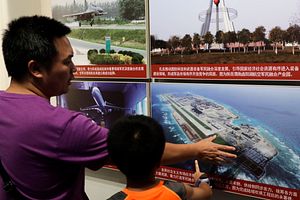In late January, Chinese state media announced the establishment of yet another new facility in a South China Sea feature. Though the unveiling was just another manifestation of an old aspect of Beijing’s broader strategy in advancing its position in the South China Sea, the initially muted response from the Philippines has once again exacerbated concerns about the regional response to such actions taken by China.
As I have noted repeatedly in these pages and elsewhere, while there has been significantly more focus on China’s efforts to assert its interests in the South China Sea in recent years, such attempts in fact date back decades. The idea of China gradually building up its position at the expense of others through a range of measures has been characterized differently over the decades, with one popular description being “creeping assertiveness” that dates back to the 1990s and Beijing’s occupation of Mischief Reef.
The idea of “creeping assertiveness” or other incrementalist characterizations of Beijing’s approach has continued on over the past few years. One aspect has been the construction of facilities – which include not just the military facilities tied to Beijing’s artificial islands, which tend to get much more attention, but also civilian facilities and capabilities as well such as weather stations and search and rescue centers. Though these facilities may appear less threatening and draw less headlines, they are nonetheless worrying for other claimant states given fears that Beijing may use ‘public good’ arguments to advance the proliferation of dual-use facilities that would advance its objectives at the expense of others.
Fiery Cross Reef has been among the features where these dynamics have clearly been at play. Indeed, China’s occupation of Fiery Cross Reef itself was done under the justification of a UNESCO marine observation station back in 1987, following which China began some construction to consolidate its position there (the feature is contested by other claimants, including the Philippines, Vietnam, and Taiwan).
The purely civilian, public-good focus of facilities Beijing has constructed on Fiery Cross Reef has also long been in question. Over the past few years, per the Asia Maritime Transparency Initiative (AMTI), Fiery Cross Reef, which is characterized as one of the “Big Three” Chinese features along with Subi Reef and Mischief Reef, has been equipped with facilities that could be employed for military uses, such as a large runway, hangar space to accommodate multiple combat aircraft, and other radar, sensor, and communications facilities.
Other claimant states no doubt recognize the creeping assertiveness at play, even though their responses have varied. That has been clearest with respect to Vietnam. Dating back to last year, Hanoi has spoken out specifically and repeatedly against the use of weather observatory stations on China’s artificial islands, making clear its opposition and demanding China cease the practice.
That is a marked contrast with the Philippines, where a relatively muted response has gained significant media coverage, particularly in light of Manila’s shifting approach. The Philippines adopted a more assertive posture under former President Benigno Aquino III, whose administration filed an arbitration case against China, but has moved to a more conciliatory one under Duterte, where the South China Sea issue has been downplayed as part of a greater effort to engage Beijing.
In late January, we saw another instance of these dynamics playing out with the announcement of another new facility. On January 29, Xinhua reported that China was constructing a new maritime rescue center on Fiery Cross Reef. The purpose of this facility, Xinhua noted, was characterized generally as being to “protect navigation and transport safety,” which is consistent with Beijing’s insistence that these facilities have civilian and defensive purposes.
Not for the first time, while the focus ought to have been on the significance of the development itself and a range of claimant responses, Duterte’s Philippines once again stole the show in terms of media headlines, with the administration’s initial response illustrating in real time some of the dangers of China’s creeping South China Sea challenge. In particular, the suggestion by Duterte’s spokesman, Salvador Panedo, that the Philippines ought to be “thankful” to China since a rescue center could benefit all, seemed to be playing right into the risks by accepting the facility itself as well as Beijing’s motivations for it, without first carefully considering Beijing’s actions up to this point and the implications for Philippine interests.
Other officials and prominent concerned observers, such as Defense Secretary Delfin Lorenzana and Supreme Court Justice Antonio Carpio, seemed to support a more traditional political response to this creeping South China Sea challenge, where Manila would look into and potentially protest the facility lest it legitimize Beijing’s future behavior. Lorenzana essentially summarized the danger of “creeping assertiveness” when he pointed out that not protesting may only encourage Beijing to continue to keep on building such facilities and consolidate its position there, which ran contrary to the Philippines’ claim to it. The Duterte administration seemed to be moving closer to that approach, with Foreign Secretary Teodoro Locsin Jr. also belatedly suggesting that this course was wise.
What Manila will actually end up doing remains to be seen and will continue to be important to watch within the broader question of how other claimant states are dealing with China’s creeping South China Sea challenge. Despite the Duterte administration’s apparent backtracking following domestic opposition, the fact remains that Duterte has been keen to avoid antagonizing China on the South China Sea issue as he pursues greater engagement with Beijing, even if it means not pushing as hard on some core Philippine interests and taking some questionable risks. That complicates both Manila’s South China Sea approach as well as the bigger picture of how claimants are responding to Beijing’s tried and true tactics with respect to this issue. Despite the clear risks and challenges inherent in this, this shows few signs of changing under the Duterte administration thus far.

































